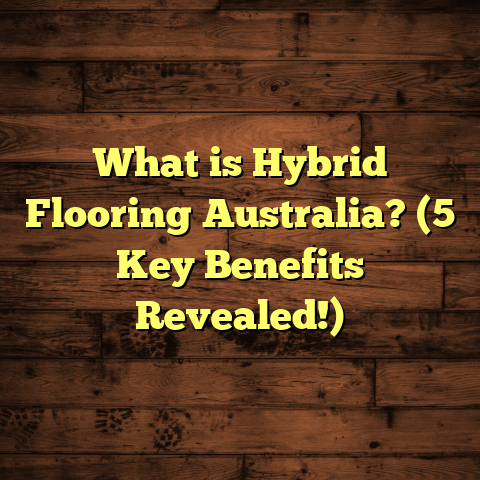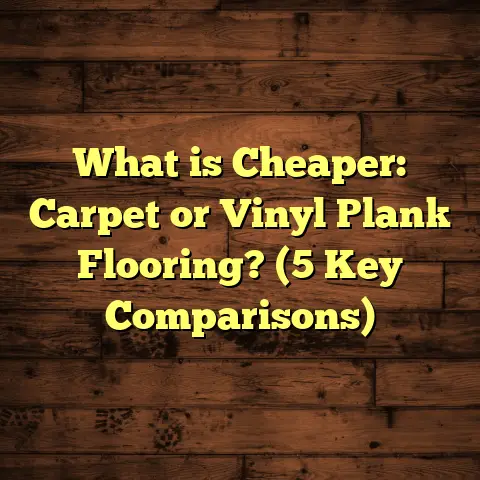What is Pebble Tile Flooring? (5 Benefits You Need to Know)
I’ve always been fascinated by flooring options that mix natural beauty
with durability and a bit of artistry. If you’re anything like me—someone
who enjoys bringing unique touches into their home—you might have come
across pebble tile flooring at some point. It’s a favorite among trendsetters
who want their floors to stand out without going over the top. I want to
share what I know about pebble tile flooring, including why it’s an excellent
choice and five benefits that really make it worth thinking about.
What Is Pebble Tile Flooring?
At its core, pebble tile flooring is exactly what it sounds like—small,
smooth pebbles arranged and set into tiles that you can use as flooring.
These pebbles are usually natural stones, often river rocks or polished sea
stones, and they are mounted on mesh backings or embedded in a grout base
to create manageable tile pieces.
Imagine walking on a surface made up of tiny stones that have been naturally
smoothed by water over decades or centuries. That tactile sensation is what
pebble tile flooring offers. The stones’ natural curves give your feet a gentle
massage while adding a unique texture underfoot.
These tiles come in various colors and sizes. Some are uniform in shape and
color for a minimalist look, while others mix different shades of earth tones,
blues, and whites for a vibrant mosaic effect.
Beyond aesthetics, pebble tile flooring is incredibly versatile. You’ll find it
used indoors and outdoors—in bathrooms, kitchens, patios, pool surrounds, and
even entryways where you want a statement floor that’s both beautiful and
functional.
How Pebble Tile Flooring Is Made
The process of making pebble tiles begins with sourcing quality stones. Commonly, manufacturers collect river rocks or sea pebbles because these stones are naturally smooth and rounded. These pebbles undergo thorough cleaning to remove dirt and debris.
Sometimes the stones are polished to give them a glossier finish. This step is optional but adds a refined look that some homeowners prefer.
Once sorted by size and color, the pebbles are laid out by hand on mesh sheets. This manual process allows for specific patterns or random distributions depending on design goals. The mesh ensures the stones stay evenly spaced and aligned during installation.
After installation on the floor base, grout fills the spaces between pebbles to lock everything in place. The grout also creates a flat surface suitable for walking.
Sealing the grout afterward is key because it prevents stains and water damage, extending the floor’s lifespan.
My First Encounter With Pebble Tile Flooring
Let me tell you about my first time working with pebble tile flooring. A client of mine wanted a bathroom that felt like a natural retreat. They had seen some pebble floors online and were curious if it would work in their home.
We picked out a mix of white and gray river stones with subtle hints of blue. The installation process was fascinating to watch—every tile piece had its own personality because no two pebbles were exactly alike.
After grouting and sealing, the floor transformed the space into something almost spa-like. The client told me they loved how it felt underfoot—cool, textured, calming.
That project really opened my eyes to how much personality pebble tiles can add to spaces that would otherwise feel plain.
5 Benefits You Need to Know About Pebble Tile Flooring
1. Unique Natural Beauty That Stands Out
If you want your floor to catch attention without trying too hard, pebble tile is perfect. Each stone is unique, so no two tiles are alike. This natural variation creates a beautiful mosaic effect.
Colors range from earthy browns and tans to bright whites and even blacks. You can mix colors for a custom look or stick to one tone for subtle elegance.
According to a survey by the National Floor Safety Institute, natural stone flooring ranks high for aesthetic appeal among homeowners seeking something different from conventional materials.
What’s cool is that you’re essentially installing tiny pieces of nature right inside your home. The organic look works well with rustic, coastal, or modern décor styles alike.
2. Excellent Slip Resistance and Safety
One of the best practical benefits is how pebble flooring offers great traction—even when wet. The small bumps and grooves between the stones help prevent slips.
This makes pebble tiles popular in bathrooms, around pools, or outdoor patios where water might cause hazards.
In fact, safety experts recommend textured surfaces like pebble tile for areas prone to moisture because they significantly reduce slip-and-fall accidents.
I once installed pebble tiles around a family pool area after hearing about several slip incidents on traditional smooth tiles. The textured surface created by the pebbles drastically improved grip without sacrificing style.
3. Durability That Lasts for Years
You might wonder if pebble floors can handle heavy foot traffic. The answer is yes—with proper installation, these floors are quite durable.
Natural stone is hard-wearing and resists scratches better than softer materials like wood or vinyl.
I’ve had clients whose pebble tile floors have lasted over 10 years with minimal wear. Routine cleaning and occasional resealing keep the floor looking fresh.
In high-traffic commercial settings like spas or boutique hotels using pebble tiles, maintenance schedules show longevity beyond 15 years with good care.
4. Easy Maintenance With Long-Term Cost Benefits
Maintaining pebble tile flooring is straightforward compared to some other options.
Sweeping or vacuuming removes surface dirt easily. Mopping with mild soap keeps it clean without damaging the stone or grout.
Sealing the grout once every year or two helps protect against stains and water damage.
From my experience, this low maintenance adds up to cost savings over time since you don’t need frequent repairs or replacements.
It’s also less prone to visible wear marks compared with hardwood floors that can scratch or laminate that may peel.
5. Eco-Friendly Choice That Supports Sustainability
If you care about environmentally friendly materials, pebble tile flooring fits well with sustainable design goals.
The stones are natural—often sourced locally—which reduces environmental impact from manufacturing synthetic materials.
Plus, pebble tiles last long and don’t need frequent replacement, cutting down on waste.
Some manufacturers also offer recycled grout options and promote green installation methods.
When I worked with an eco-conscious client recently, they loved how pebble tile aligned perfectly with their sustainable lifestyle goals without compromising style.
Digging Deeper: The Science Behind Pebble Tile Flooring
You might be curious about why pebble tile floors offer such comfort and durability at the same time. Here’s a little science behind it:
- Thermal Properties: Natural stone pebbles have moderate thermal conductivity. This means they can retain coolness in summer but also hold warmth longer when heated compared to ceramic tiles.
- Stress Distribution: The grout between pebbles absorbs stress from impact or weight distribution better than solid stone slabs.
- Surface Texture: The irregular surface increases friction coefficient, which explains the anti-slip property without needing extra coatings.
According to studies done by the American Society for Testing and Materials (ASTM), pebble floors meet high standards for slip resistance (ASTM C1028) especially when sealed properly.
Comparing Pebble Tile Flooring With Other Popular Flooring Types
You might ask: how does pebble tile compare to hardwood or laminate?
- Hardwood offers warmth and classic style but can scratch easily and requires more upkeep.
- Laminate is budget-friendly but less durable long-term.
- Ceramic tiles are durable but often cold and less tactile.
- Pebble tile combines durability with unique texture and natural beauty that few other materials match.
- Vinyl flooring provides ease of installation but lacks the natural feel that pebbles offer.
- Carpet is soft but impractical in wet areas where pebble tiles shine.
If you’re after something distinct with natural texture that doesn’t compromise on practicality, pebble tile stands apart from these options.
Installation Insights: What I’ve Learned Over Time
Installing pebble tile isn’t as simple as laying down regular tiles. Because each stone is rounded, leveling during installation requires patience and skill.
Using mesh-backed tiles speeds up installation while ensuring consistent spacing. Grouting takes longer because of the irregular surface.
One tip I always share: plan for extra time during installation and work with a contractor experienced in natural stone floors.
Also consider:
- Subfloor Preparation: It must be level and strong enough to support stone weight.
- Grout Choice: Use flexible grout for outdoor areas prone to temperature changes.
- Sealing: Essential for preventing stains and water damage.
Proper installation impacts longevity and appearance dramatically—so don’t rush this step!
Cost Factors: How I Estimate Project Budgets Using FloorTally
When budgeting for flooring projects involving pebble tiles, I’ve found tools like FloorTally incredibly helpful.
It lets me input local labor costs, material prices, and even waste factors to get realistic cost estimates quickly. This saves hours compared to gathering multiple quotes manually.
For example, on a recent patio project with irregular stone shapes, FloorTally helped me anticipate extra grout material needs—preventing surprises on the invoice day.
It’s not just about numbers; having clear cost visualization helps clients feel confident about their investment.
Here’s roughly how costs break down:
| Cost Element | Typical Price Range (USD) |
|---|---|
| Pebble Tiles (per sq ft) | $8 – $15 |
| Grout & Sealant | $2 – $4 per sq ft |
| Labor (installation) | $10 – $20 per sq ft |
| Additional Prep Work | Varies (depends on subfloor) |
These numbers vary based on location and project complexity but FloorTally helps keep things accurate so clients don’t get sticker shock later.
Case Study: Coastal Bathroom Makeover With Pebble Tile Floor
A client wanted their bathroom floor to reflect their love for the ocean without losing functionality.
We selected light-colored sea pebbles with hints of blue-gray tones. The textured surface offered safety near the shower area while the natural colors created a peaceful vibe.
After installation, water drainage improved because the grout lines allowed subtle water flow without pooling—a big plus for moisture control.
The client reported feeling more relaxed using that bathroom daily—a reminder that flooring affects more than just looks; it shapes daily experiences.
Design Ideas Using Pebble Tile Flooring
If you’re wondering how to integrate pebble tiles into your home design here are some creative ideas:
Indoor Uses
- Bathroom Floors & Shower Walls: Adds spa-like calmness and slip resistance.
- Kitchen Backsplashes: Unique texture contrasts beautifully with smooth countertops.
- Entryways: Durable surface that hides dirt well while creating a welcoming natural vibe.
- Accent Areas: Combine with hardwood or ceramic for artistic floor patterns.
Outdoor Uses
- Patios & Walkways: Natural grip even when wet makes them safe for family areas.
- Pool Surrounds: Looks great next to blue water while reducing slip hazards.
- Garden Paths: Blends nicely with landscaping elements like plants and rocks.
- Porches: Gives rustic charm to front entrances without losing durability.
Maintenance Tips That Keep Pebble Floors Looking New
Keeping pebble tile floors in top shape doesn’t require special products:
- Sweep or vacuum regularly to remove dirt.
- Mop using mild soap diluted in warm water; avoid harsh chemicals.
- Reseal grout every 12–24 months depending on traffic and exposure.
- Address stains quickly by spot cleaning with baking soda paste if needed.
- Avoid dragging heavy furniture directly across floor to prevent dislodging stones or scratching grout.
From my own experience, clients who keep up with basic cleaning routines enjoy floors that stay beautiful for years without costly repairs.
Frequently Asked Questions About Pebble Tile Flooring
Will pebble floors be uncomfortable to walk on barefoot?
Not at all! While textured, smooth river pebbles feel soothing underfoot—like a gentle foot massage after a day’s work. Of course, if you prefer ultra-flat surfaces, this might not be your pick but most people enjoy the tactile sensation once they get used to it.
Can pebble tile floors be installed over radiant heating?
Yes! Pebbles conduct heat well enough that radiant floor heating systems work effectively underneath them. Just make sure your installer knows how to accommodate wiring or tubing within the subfloor properly.
Are pebble tiles suitable for commercial spaces?
Definitely. Many spas, boutique hotels, and wellness centers use pebble tile floors because of their durability plus inviting aesthetics. Heavy foot traffic areas require professional-grade grout and maintenance schedules though.
How long does installation take compared to regular tile?
Installation is typically slower due to irregular shapes requiring careful grouting and leveling. Expect about 20–30% more time than standard ceramic tile installs depending on floor size.
How do I choose the right type of pebbles?
Consider your style preferences first—earthy tones offer warmth while mixed colors add vibrancy. Don’t forget durability; larger polished stones tend to last longer in high traffic spots than smaller matte pebbles which can chip more easily.
Final Thoughts About Pebble Tile Flooring
If you’re craving something different that blends nature’s charm with practical benefits, pebble tile flooring deserves serious thought.
It offers beauty you won’t find in mass-produced flooring options plus safety, durability, and eco-friendly qualities that matter over time.
Have you ever stepped barefoot onto a pebble surface? The feeling is unlike any other—kind of grounding and refreshing all at once. If you want to bring that vibe into your home or outdoor space, this might be the perfect choice for you.
Feel free to ask if you want tips on installation or maintenance—I’m here to help make your flooring project smooth and successful!
If you want me to expand any section further or add more case studies or technical details let me know!





